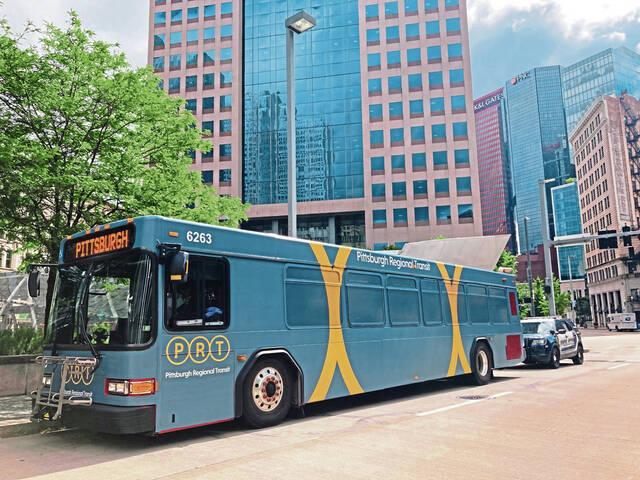https://triblive.com/local/pittsburgh-regional-transit-says-worker-shortages-other-issues-contributing-to-service-cuts/
Pittsburgh Regional Transit says worker shortages, other issues contributing to service cuts

The pandemic hit public transit agencies hard, especially with decreases in ridership and large service cuts, and Pittsburgh Regional Transit has not avoided those issues.
Starting on Nov. 20, PRT will reduce service hours by nearly 2%, which will impact 11 bus routes and the blue line light-rail route, according to PRT board member John Tague.
Overall, the reduction means 488 hours of service will be reduced per week, out of more than 27,000 weekly hours, according to PRT.
Katharine Kelleman, the agency’s CEO, said at a board meeting Friday that persistent worker shortages in the transit operator and maintenance departments are the main reason for service cuts.
“It is our top concern and our top priority today, to keep people in and to restore the cuts to the community that we have had taken away,” Kelleman said. “We thought it would be solved by now and it has not been.”
She said PRT is not alone in dealing with worker shortages, noting that 71% of transit agencies across the United States have cut service.
Kelleman said that PRT has been cutting service incrementally over the past several months in response to its worker shortage problems. Overall, PRT service hours are down close to 8% compared to normal.
Kelleman said PRT doesn’t want to reduce service hours, but said staffing issues and worker retention has put the agency in the tough position to avoid having route frequency decrease too drastically.
Until the cuts are instituted in November, PRT is about 46 positions short to keep up with its service requirements. Once the service cuts are made, they will have five surplus staffers, said PRT spokesman Adam Brandolph.
She lauded current PRT operators who have been working overtime and on tough schedules to try to keep service satisfactory, but understands that riders are struggling.
“Our operators have stepped up and they have answered this charge,” Kelleman said. “But people can only work so much.”
Several people who addressed the board Friday shared their frustration with the service cuts and how the cuts have negatively impacted their lives.
Sherai Richardson, who is currently living in a homeless shelter, said there have been times when buses are not showing up and she has been left waiting for over an hour.
“To get to the doctor’s appointment and get to the grocery store, it is kind of scary actually, to think that I can be stranded somewhere,” Richardson said.
Ricardo Villarreal, of Mt. Washington, said he takes the red line light-rail line twice a day. The shuttle that has been put in place while crews work on the red line has been unreliable, he said.
“There is this feeling of hopelessness when our transit doesn’t arrive on time, or doesn’t arrive at all,” Villarreal said.
Jordi Gonzalez, a student at Carnegie Mellon University, said that if predictability were improved for PRT vehicles, then maybe the service cuts wouldn’t hurt riders as much.
Laura Chu Wiens, director of advocacy group Pittsburghers for Public Transit, said the cuts have put service in Allegheny County into the lowest levels in decades. She criticized PRT for not addressing the service cuts more seriously, and said the firing of 80 workers because of PRT’s vaccine mandate for employees hurt.
“We are here to demand that PRT create a plan,” Wiens said.
Cheryl Stephens, also of Pittsburghers for Public Transit, disagreed that worker shortages were leading to service cuts. Instead, she blamed poor management and scheduling. She said bus operators are on schedules that are too tight and, as a result, are consistently behind and forced to skip breaks.
“Not surprised that no one wants this job, because how can you sustain this workforce,” said Stephens.
Kelleman pushed back on the claims and said PRT is working diligently to accommodate operators and attract and retain staff. She said in addition to being short on operators, it’s been difficult to retain staff and accommodate all the vacation time requests that have stacked up.
She said PRT is working with the transit operators union on benefit negotiations, and is looking at benefits such as child care vouchers and student loan payments to help retain and attract workers.
She also disagreed that the vaccine mandate is affecting service. She said even though PRT is making cuts, it has made far fewer cuts than cities such as Jacksonville, which doesn’t have a vaccine mandate. Kelleman said that since the mandate took effect in March, no PRT worker has died or been hospitalized due to covid-19.
As of January, seven PRT employees had died due to covid.
PRT is also still well under its ridership totals from before the pandemic, but Brandolph said that worker shortages are the main reason for service cuts, not ridership decreases.
Copyright ©2025— Trib Total Media, LLC (TribLIVE.com)
